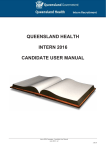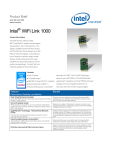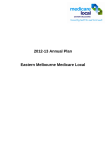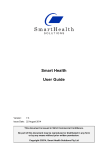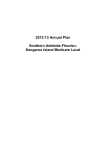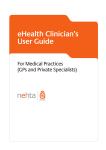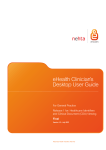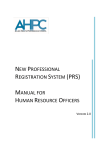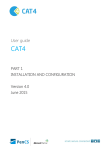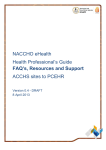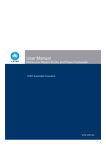Download Medicare Local Annual Plan template and user guide
Transcript
2011-12 Annual Plan South Eastern Melbourne Medicare Local Document History Version No. 1 Date 24 February 2012 Description of Revision 2011-12 Annual Plan for South Eastern Melbourne Medicare Local 1 Table of Contents 1 Organisational overview .................................................................................... 3 1.1 Medicare Local contact information............................................................ 3 1.2 Medicare Local region characteristics ........................................................ 4 1.3 Organisational structure and internal governance ...................................... 7 1.4 Board membership................................................................................... 10 1.5 Company membership ............................................................................. 11 1.6 Company objects ..................................................................................... 13 1.7 Key stakeholder relationships .................................................................. 14 1.7 Subcontractors......................................................................................... 17 1.8 List of attachments ...................................... Error! Bookmark not defined. 2 Medicare Locals Core Funding Program ......................................................... 18 2.1 Key activities ............................................................................................ 18 2.2 Risk management plan – Medicare Local core funding program .........Error! Bookmark not defined. 2.3 Transition arrangements ............................. Error! Bookmark not defined. 2.4 Additional Program information or Program material .. Error! Bookmark not defined. 3 Medicare Local After Hours Program ............................................................... 24 3.1 Risk management plan – Medicare Local After Hours Program ..........Error! Bookmark not defined. 2011-12 Annual Plan for South Eastern Melbourne Medicare Local 2 1 Organisational overview 1.1 Medicare Local contact information Medicare Local name: Medicare Local legal name (if different): ABN: Postal address: Street address: Phone: South Eastern Melbourne Medicare Local South Eastern Melbourne Medicare Local Inc Fax: 03 9793 4050 Email: Website: Branch office information: www.semml.com.au 14 154 821 182 314B Thomas Street Dandenong 3175 314B Thomas Street Dandenong 3175 03 8792 1911 2011-12 Annual Plan for South Eastern Melbourne Medicare Local 3 1.2 Medicare Local region characteristics Geographic Location of South Eastern Melbourne Medicare Local (SEMML) Map 1: SEMML – indicating Local Government Areas Map 2: SEMML – location in relation to central Melbourne 2011-12 Annual Plan for South Eastern Melbourne Medicare Local 4 South Eastern Melbourne Medicare Local - Population base The South Eastern Melbourne Medicare Local’s (SEMML) catchment includes three Local Government Areas (LGA): the Cities of Greater Dandenong and Casey, and the Shire of Cardinia (see Map 1 above). The City of Casey and the Shire of Cardinia are two of the fastest growing areas in Australia. The population across the 3 local government areas is extremely diverse. The current catchment population of approximately 454,000 is expected to increase to 629,000 by 2022, a growth of 38.7%1. The current population distribution is: 15% in Cardinia, 55% in Casey and 30% in Greater Dandenong. City of Greater Dandenong The City of Greater Dandenong is the most culturally diverse locality in Victoria and an area of high disease burden; there are a large number of households with low income, 56% of residents born overseas and low English proficiency. In December 2010, the City of Greater Dandenong produced a report entitled ‘Health and Wellbeing in Greater Dandenong’. The report indicated in 2008/09, 2,470 recently arrived migrants settled in Greater Dandenong – the largest number of migrant settlers in any Victorian municipality. Nearly a fifth of these people were humanitarian immigrants, largely from countries such as Afghanistan, Burma, Iraq, Sudan and Sri Lanka. The culturally diverse population of Greater Dandenong requires a renewed focus on improving the health literacy of patients with limited English proficiency through the use of health interpreters. There is evidence that supports language barriers decrease equity in health care by reducing the patients understanding and involvement in decision making and decreasing adherence to treatment including medications. The Victorian Population Health Survey found that levels of obesity were higher (17% compared to 12%) among people who were indigenous, disadvantaged, less educated, unemployed, those who ran out of food in the previous 12 months, and people who were experiencing the highest levels of psychological stress. The paper reported that 18% of Greater Dandenong residents (18,000 people) suffer one form of depression and 6.7% (7,000 people) of major depression. 6% of people had a severe profound disability in Greater Dandenong, compared to 4.3% in the rest of Melbourne. City of Casey The City of Casey is Victoria’s largest and fastest growing municipality and the dominant growth area for south-eastern Melbourne with new families settling in Casey at a rate of 40 per week. The key features of this region include: 1 The youngest age profile of all Melbourne LGAs 29% of population aged under 18 compared to 23% in metropolitan Melbourne 65,000 (30%) of residents born overseas An increasing number of refugees Dept of Health, 2011, Metropolitan Health Plan Technical Paper 2011-12 Annual Plan for South Eastern Melbourne Medicare Local 5 Cardinia Shire The Cardinia Shire is located on the south-east fringe of metropolitan Melbourne, unlike the majority of the LGAs encompassed in greater Melbourne; Cardinia has a large rural population giving it unique geographical features and service provision issues. The Cardinia Shire has by far the highest proportion of its citizens living in rural communities, while roughly one-third of the residents of Yarra Ranges, Mornington Peninsula and Hume live outside an ‘urban’ centre. This has major implications for Cardinia Shire residents’ ability to access the resources they need for their primary, secondary and tertiary health needs. 29.8% of residents are under the age of 18 compared to 23% in metropolitan Melbourne 7,980 (14%) residents born overseas Population Projections Over the next 10 years, the catchment areas of Casey and Cardinia are expected to be one of the fastest growing municipalities in Australia. The highest population growth within the SEMML catchment is expected within the City of Casey and Cardinia which is expected to increase by 121,069 (53%) and 57,288 (94%) people respectively between 2007 and 2021. In contrast, the City of Greater Dandenong is expected to experience relatively more stable population growth levels but will continue to receive high numbers of migrant and refugees. The number of Aboriginal & Torres Strait Islanders in the SEMML catchment is reported at just under 2,000. It is recognised that diabetes, cardiovascular disease, mental health and respiratory disease are priority areas that need to be addressed with this population group. Health Service Infrastructure and Utilisation According to recent data from the Victorian Department of Health the SEMML region is relatively well served with hospital services, comprised of the two major hospitals, Casey and Dandenong, and three smaller services: Queen Elizabeth Centre; Cranbourne Integrated Care Centre; and Koo Wee Rup Regional Health Service. Mental health and aged care services are lacking in proportion to the population of this area. Whilst the catchment has 11.1% of metropolitan Melbourne’s current population it has only: 10.7% of GP services 6.2% of mental health services 7.4% of aged care services With the region expected to experience the third highest percentage growth in population of all Victorian regions, pressure on these services is set to increase2. A sustainable workforce will be a significant issue. A number of key demographic characteristics pose challenges to the health of the community and will be priorities for SEMML. These include: 2 significant areas of socioeconomic disadvantage Dept of Health, 2011, Metropolitan Health Plan Technical Paper 2011-12 Annual Plan for South Eastern Melbourne Medicare Local 6 diabetes and mental health Aboriginal and Torres Strait Islander health health issues associated with refugee resettlement. 1.3 Organisational structure and internal governance 2011-12 Annual Plan for South Eastern Melbourne Medicare Local 7 Governance Structure Board Strategic Advisory Committee ** Consumer/Community Reference Group Clinical Advisory Committee (includes Clinical Governance) Population Health Working Group** Program Advisory Groups** Aged Care After Hours Working Group** Mental Health Refugee Health Aboriginal Health Refugee Health** Research Consortium Compliance, Audit, Risk Management (CARM) ** Southern Health (LHN) representation Tender & Contract Compliance Review Nominations Committee Time limited working groups 2011-12 Annual Plan for South Eastern Melbourne Medicare Local as at March 2012 8 Informatics eHealth Organisational Structure Board CEO Executive PA Director Business Services Finance Governance Contract Management Human Resources Office Administration Marketing & Communication Director Primary Care & Clinical Services Chronic Disease including diabetes (DCAS) Mental Health (incl. ATAPs) Closing the Gap Refugee Health Aged Care Integration/eHealth 2011-12 Annual Plan for South Eastern Melbourne Medicare Local Director Population Health & Planning Population & primary health planning Needs Assessments Data management and analysis Health promotion & prevention Evaluation & research 9 Director Stakeholder Engagement & Workforce Development Stakeholder engagement Consumer/Community Liaison After Hours Coordination Private Providers/Clinical workforce: Engagement support and development 1.4 Board membership Position on board Name Chair Nicholas Demediuk Expertise Profession Date appointed General practice, corporate governance GP 16.12.11 CEO 16.12.11 IT consultant, business woman 16.12.11 General practice GP 16.12.11 Aboriginal Health Academic GP Education & training Researcher Knowledge of local community & health care providers Deputy Chair Peter Waters Mental health, corporate governance, business management Knowledge of local community & health care providers Director Jan Begg Corporate governance, risk management, business management Information technology Director Hung The Nguyen Cultural competency Corporate governance Director Helen Keleher Public Health Academic Population health planning Researcher 16.12.11 Nursing/allied health Education Director Martin Wischer Community nursing Corporate governance Business Management Knowledge of local community & health care providers Director Sally McDonald Aged care/Palliative care General Manager, Royal District Nursing Service 16.12.11 GP 16.12.11 General Practice Governance experience Knowledge of local community & health care 2011-12 Annual Plan for South Eastern Melbourne Medicare Local 10 providers Director Roy Sanderson Finance/accounting Accountant Business Management Business man Corporate governance Director Brett Ogilvie General practice GP 16.12.11 16.12.11 Governance experience Workforce education and support Knowledge of local community & health care providers 1.5 Company membership Membership structure – South Eastern Melbourne Medicare Local 1. MEMBERSHIP 1.1 Classes of Membership The membership of the Company is divided into two classes: 1.2 (a) Founding Members, being the Members of the Company as at the date of its registration; and (b) Other Members, being Members who are not Founding Members. Members The Members are the initial Members as identified in the application for incorporation of the Company to the Australian Securities and Investments Commission and such other persons as the Company admits to membership in accordance with this constitution. 1.3 Membership not transferable A Member's rights, privileges and benefits of membership are personal to the Member and membership of the Company is not transferable, other than by operation of law. 1.4 Application for membership (a) A person is eligible to apply for membership if the person is a body corporate, partnership or unincorporated body other than a natural individual, which has a substantial interest or involvement (whether directly or indirectly) in the provision of primary health care within the Catchment, or as otherwise determined by the Board. (b) A person eligible to apply for membership may submit an application for membership to the Board. 2011-12 Annual Plan for South Eastern Melbourne Medicare Local 11 The South Eastern Health Providers Association is the Founding Member. Membership is available to organisations operating in the South Eastern Melbourne Medicare Local area who offer services to the community in health, or a related field, to support the social determinants of health. Organisations are defined as but not limited to: offering direct service provision by employees eligible for registration through Australian Health Practitioner Regulation Agency (AHPRA) a peak body that represents providers eligible for registration through AHPRA relevant health or health related Consumer Organisations that represent consumers in the South Eastern Melbourne Medicare Local area health planning authorities such as Local Government health related organisations such as those involved in housing, employment or education health promotion and prevention organisations the tertiary education sector. All membership applications will be forwarded to the Board of the South Eastern Melbourne Medicare Local for endorsement. There is no membership fee. The Board decision is final, post notification of an outcome, no further correspondence will be entered into. The Rights of Members Right to expect the highest standards of good governance by the company Right to communication Right to be heard Right to suggest directors to the Nominations Committee The Responsibilities of Members Responsibility to support the aims of the Medicare Local Responsibility to ensure an appropriate representation is appointed Responsibility to attend General Meetings Responsibility to take an active interest in the Medicare Local Responsibility to direct concerns about the Medicare Local to the company in the first instance Members become eligible to be appointed to advisory committees and reference groups, and the Board will give regard to the advice of these groups. This provides opportunity to influence the Board and provide direction on matters relevant to key stakeholders. Membership structure Founding Member: The South Eastern Health Providers Association as the Founding Member has over 350 GP members and, to date, just over 70 other health providers as members as at March 2012. These include allied health professionals, psychologists, practice nurses, chiropractors and pharmacists. 2011-12 Annual Plan for South Eastern Melbourne Medicare Local 12 Organisational Members Invitations to organisations to apply for membership will be circulated widely at the end of March 2012. It is anticipated that the members of the original consortium who supported the Invitation to Apply and have been involved to date in planning and early establishment will be the first organisations to officially join the SEMML. These are: Dandenong & District Aborigines Co-Op Ltd South East Migrant and Refugee Centre Southern Health Royal District Nursing Service Ermha Inc Monash University Koo Wee Rup Regional Health Service 1.6 Company objects 2. OBJECTS 2.1 The Principal Object for which the Company is established is to be a health promotion charity within the meaning of item 1.1.6 of section 30 – 20 of the Income Tax Assessment Act 1997 (Cth) by establishing, promoting and operating a Medicare Local in South Eastern Melbourne. 2.2 Subject always to its Principle Object, the Company also has the following objects: (a) to encourage and support improvements in the delivery of primary health care services to patients including initiatives aimed toward improving disease prevention and management, raising patient awareness and improving access to appropriate services; (b) to improve the planning of primary health care services to identify health needs of the community, develop locally focused and responsive health services and address service delivery gaps; (c) to promote primary care and the centrality of general practice for the delivery of effective integrated health management for the local community; (d) to provide support to clinicians and health service providers to improve their patient care; (e) to establish effective collaborations to deliver more coordinated, integrated, flexible and locally responsive health services; (f) to promote a culture of efficiency, accountability and continuous improvement in the delivery of primary health care services; (g) to raise money to further the aims of the Company and to secure sufficient funds for the objects of the Company; (h) to receive any funds and distribute these funds in a manner that best 2011-12 Annual Plan for South Eastern Melbourne Medicare Local 13 attains the objects of the Company; (i) to do all such other things as are incidental or conducive to the operation of the Company and otherwise for the attainment of all or any of the above objects of the Company; and (j) to operate consistently with its guiding principles. 2.3 Solely for the purpose of furthering the Principle Object, and without limiting the powers of the Company under the Act, the Company may do all things incidental or conducive to furthering the Principle Object. 2.4 Guiding Principles In pursuing its Principle Object, the Company will seek in all its operations: (a) to develop service responses that facilitate the care of the whole person through and understanding of the interplay between the biological, psychological and social determinants of health and the need to provide comprehensive continuing care; (b) to advocate and work to address the social and structural factors, including inequity and exclusion, which contribute to ill health and poor wellbeing; (c) to facilitate the participation of consumers, carers and community members in all facets of their health and wellbeing and in the work of the Medicare Local; (d) to build strong and effective partnerships with the local agencies through a shared understanding and commitment to person centred care and professional respect across the disciplines; (e) to promote the delivery of high quality, accessible, effective and safe services to the communities within the Catchment; and (f) to ensure the delivery of services that are culturally appropriate. 1.7 Key stakeholder relationships Patients and consumers (including Aboriginal and Torres Strait Islander representatives) The SEMML will consult with the Consumer Health Forum and Health Issues Centre to gain advice and input into the establishment of the Consumer/Community Reference Group Engagement of consumer representatives on planning and reference groups where possible will be achieved. A number of community workshops/forums will be held to inform the community on the role of the SEMML Interviews and focus groups within the community will be conducted for particular programs such as Refugee Health and chronic disease management The local media will be utilised together with website/social media The current Consumer/Community Reference Group will continue to meet and provide input and advice on planning and identification of needs and priorities for the SEMML. It is anticipated that some members of this group 2011-12 Annual Plan for South Eastern Melbourne Medicare Local 14 will transfer to the SEMML consumer group. There will be consultation with the Dandenong & District Aborigines Cooperative to ensure appropriate input and representation Clinicians, health services providers and their representative bodies (across the spectrum of primary care, and where relevant secondary and acute care and Aboriginal and Torres Strait Islander representatives) General practice will remain integral to the work of the SEMML. There will be representation of general practice on advisory committees, reference groups etc. Programs and services provided to general practice that assists in patient access and services will continue together with support to all levels of practice staff. There will be greater opportunity for Allied Health Professionals and other health providers to be engaged in networking, advisory roles and representation. They will be able to access services and support funded through the SEMML. The current membership of what was the Dandenong Casey General Practice Association will continue with the South Eastern Health Providers Association (Founding Member of SEMML) with the addition of other health providers including allied health professionals, practice nurses, psychologists, pharmacists and dentists. Specialists also may choose to join the Association. Local Hospital Networks The strong partnerships in various program areas together with the cross membership of key committees and advisory groups will continue between Southern Health and the SEMML. The SEMML will have representation on the Southern Health Population Health & Primary Care Advisory Group and Southern Health will have representation on various committees within the SEMML. The Southern Health General Practice Liaison Unit will become the Medicare Local Liaison Unit and continue to fund a shared liaison project officer. The Koo Wee Rup Regional Health Service will have representation on all relevant advisory committees and sub committees. Established links and liaison with private hospitals in the region will continue. Local Lead Clinician Groups (once established) SEMML will work in line with the directives from the Commonwealth in relation to the establishment of the Local Lead Clinical Group. Community organisations The Strategic Advisory Committee has been established and reports directly to the Board. This is the primary representative body and its membership is selected, in part, to equitably represent the full range of primary care providers in the community as well as agencies with a major stake in primary care performance (e.g. LHNs, local government) and consumers. It is expected that it will have the greatest repository of detailed local knowledge. It will be responsible for recommending strategic priorities and approaches to the board Consumer/Community Reference Group will facilitate and guide the process of consultation with the community and ensure that all planned activities are appropriately reviewed from a consumer perspective. It will report to the Strategic Advisory Committee a member of which will be its Chair. 2011-12 Annual Plan for South Eastern Melbourne Medicare Local 15 State/Territory government The Strategic Advisory Committee will ensure a continued strong linkage with the South East Healthy Communities Partnership (SEHCP) and its member agencies, Southern Health (local hospital network), local governments including Cardinia Shire, City of Casey and City of Greater Dandenong in order to retain the best possible perspectives and approaches in addressing health issues. These organisations will have strong representation on this and other relevant advisory groups. Representatives from the Victorian Southern Metropolitan Region Department of Health and Ageing have actively participated in the establishment of the SEMML. There is continued ex officio representation on the Strategic Advisory Committee. Every effort is being made to align and share data for population health and health service planning in the south eastern growth corridor. Southern Metropolitan Region Department of Health & Ageing, local government, Southern Health, the South Eastern Healthy Communities Partnership and the SEMML are working collaboratively to avoid duplication and share information. Researchers and educators Research, evaluation and education will be a high priority and collaboration with universities and other tertiary level organisations will continue. The Southern Academic Primary Care Research Unit (SAPCRU) will provide valuable on-site support and services to assist in identifying emerging health needs and advise on research and evaluation opportunities. In collaboration with the Monash University School of Primary Health Care, students from medicine, nursing, allied health both undergraduate and postgraduate will be provided with opportunities to work on research projects within the SEMML. Other key stakeholders Organisations and/or government departments relevant to education, housing, transport and environment will be welcome to participate in advisory/reference groups where it is apparent that the social determinants of health need to be addressed. 2011-12 Annual Plan for South Eastern Melbourne Medicare Local 16 1.7 Subcontractors Name Program Services South Eastern Health Providers Association Core General Practice Support & Services Engagement of allied health professionals & other health providers April to June 2012 Value 2011-12 Annual Plan for South Eastern Melbourne Medicare Local Tender process South Eastern Health Providers Association (formerly DCGPA) selected directly for the 3 month period to ensure continuity of services, retain general practice engagement and further engagement of other health providers. 17 Other contracts/ arrangements Nil Conflict of interest 3 Directors of SEMML on the Board of South Eastern Health Providers Association. Conflict declared at SEMML Board meetings 2 Medicare Locals Core Funding Program 2.1 Key activities Strategic Objective Improving the patient journey through developing integrated and coordinated services Key Activities Timeframe 1.1 In collaboration with Southern Health (acute & community services) and other relevant stakeholders expansion of the Diabetes Coordination & Assessment Service (DCAS) model to include other areas of chronic disease March 2012 onwards 1.2 Incorporate the Care Coordination & Supplementary Services (CCSS) scheme for Aboriginal people with chronic illness referred by their GP for service coordination into the DCAS model. As a member of the Diabetes Consortium and with oversight from the SEMML Clinical Advisory Committee, build on the collaborative achievements to date and expand the drive for integration and coordination of all diabetes services across the SEMML catchment April 2012 1.4 In considering future directions for No Wrong Door include scoping whether the decision trees/search functions can be integrated with general practice systems & expansion of the Choose and Redirect tool to include a broader range of health services and agencies. June 2012 1.5 Mental Health Assessment and Referral Service (MHARS) – the one stop shop where GPs refer patients with mental health issues will expand to include Tier 1 and Tier 2 Access to Allied Psychological Services (ATAPS) over the wider catchment of the SEMML. In collaboration with Southern Health and other relevant stakeholders, opportunities to improve local service communication, service planning, integration and coordination will be explored with the aim of improving the patient journey. Projects addressing electronic communication from Southern Health hospital sites to general practice will continue. March 2012 onwards 1.3 1.6 2011-12 Annual Plan for South Eastern Melbourne Medicare Local 18 February 2012 onwards March 2012 onwards Improving the patient journey through developing integrated and coordinated services (continued) 1.7 Southern Health will be represented on the SEMML Strategic Advisory Committee and the strong relationship between the Southern Health General Practice Liaison Unit and local general practice will be supported. March 2012 onwards 1.8 The Strategic Advisory Committee will oversee the establishment of a Consumer/Community Reference Group. The Consumer Health Forum and/or the Health Issues Centre will be invited to provide input into the formation and role of the group. Allied Health Directory The current Allied Health Directory maintained by the South Eastern Health Providers Association will be incorporated into the Victorian Human Services Directory and subsequently to the National Health Services Directory. A broader range of health providers will be included in the directory with the aim of connecting consumers and practitioners across the catchment. SEMML will assess and support the readiness for the Patient Controlled Electronic Record (PCEHR) by assisting organisations & individuals in the application for Healthcare Provider Identifier (HPI-O & IHI – I) General practices will receive on-site support and education. Introduction to the PCEHR will be provided at forums for general practice, private allied health and other health providers. May 2012 2.1 The Aboriginal and Torres Strait Islander Quality Improvement in General Practice Program will be extended to include working with private allied health service providers and continue work with nine existing private general practices. A priority will be to promote integration by ensuring clinicians are referring/linking to Aboriginal community controlled health services and other appropriate agencies. February 2012 onwards 2.2 The General Practice Data – Practice Information Management Support Program will continue to work with general practices to support the use of information management and data extraction tools in general practice. Further practices will be engaged in data collection, analysis and quality improvement activities. March 2012 onwards 1.9 1.10 1.11 Provide support to clinicians and service providers to improve patient care 2011-12 Annual Plan for South Eastern Melbourne Medicare Local 19 June 2012 March 2012 onwards March 2012 Provide support to clinicians and service providers to improve patient care (continued) 2.3 Aggregated de-identified general practice data will provide important population level data for SEMML to support ongoing planning and evaluation in the areas of preventive health and chronic disease management SEMML will conduct an initial investigation into the best way to support private allied health providers in the collection and use of health data for quality improvement. March 2012 onwards 2.5 Support for General Practice Accreditation and Standards will expand to include the wider SEMML. The current Accreditation Advisory Group will restructure to accommodate a broader membership base that also represents allied health providers, specialists and dentists. March 2012 onwards 2.6 Expand on the Continuing Professional Development program provided to GPs, Practice Nurses and practice staff to engage and support educational activities across the spectrum of primary health care providers. This will include multidisciplinary education, training and participation in the state-based Southern Clinical Placement Network which plans, coordinates and evaluates clinical placements in health organisations across the region. March 2012 onwards 2.7 Allied Health Professional Engagement Commence engagement of allied health professionals and other primary health providers via newsletters, community forums, and education events. First forum to be held on 21 March 2012. The SEMML governance structure will promote and enable allied health/health provider representation on relevant planning and advisory committees. March 2012 onwards 2.8 Determine the support needs of the various health provider groups. This will include private allied health professionals, dentists, pharmacists, and psychologists. The Immunisation Task Force with representation from local government, GPs, Paediatricians, Department of Health and Medicare Australia will continue to oversee and support proactive immunisation strategies across the catchment. It will be expanded to incorporate the Cardinia Shire. The integrated approach developed through the Diabetes Consortium will continue to develop with assistance from the Consortium Clinical Practice June 2012 2.4 2.9 2.10 2011-12 Annual Plan for South Eastern Melbourne Medicare Local 20 June 2012 March 2012 ongoing June 2012 Provide support to clinicians and service providers to improve patient care (continued) Identification of the health needs of local areas and development of locally focused and responsive services Group. The potential to embed this work within the SEMML will be explored with other key members of the consortium with the aim being sustainability of the consortium and clear reporting mechanisms. 2.11 The Refugee Health Program will continue to work with general practices and be extended to include allied health service providers. A priority will be to promote appropriate care to refugees. March 2012 onwards 3.1 The SEMML will undertake an assessment of local population health needs and use this information in planning and priority setting. This will be done in collaboration with other key stakeholders who also undertake population health planning, e.g. local government, Southern Health, State Government. Every endeavour will be made to avoid duplication, share information and work together in determining priorities. The Refugee Health Needs Assessment completed in 2011 will be incorporated into the overall needs assessment. The findings of the Refugee Health Needs Assessment and subsequent regional planning forum will inform joint planning and setting of priorities for the SEMML. May 2012 3.4 The SEMML governance structure will ensure representation at the Strategic Advisory Committee level from agencies that provide services to refugee groups. March 2012 3.5 The experience and advice from the Refugee Health Needs Assessment and the Refugee Health Research Consortium will be used to inform planning and implementation for other marginalised groups/specific care needs within the SEMML. April 2012 3.6 The SEMML Strategic Advisory Committee will have representation from the Dandenong & District Aborigines Cooperative. March 2012 onwards 3.7 The learnings from the CCSS initiative will inform future planning and further innovation to respond to the needs of the Aboriginal and Torres Strait Islander community. Coordination of these services will be facilitated by inclusion in the DCAS model, i.e. ‘one stop shop’ for referral. May 2012 3.2 3.3 2011-12 Annual Plan for South Eastern Melbourne Medicare Local 21 May 2012 May 2012 onwards 3.8 Identification of the health needs of local areas and development of locally focused and responsive services (continued) Facilitation of the implementation and successful performance of primary health care initiatives and programs Ongoing analysis of health service usage through interagency collaboration will assist SEMML in identifying areas for improvement and establishment of priorities, e.g. waiting times for services. March 2012 onwards 3.9 Linkages already established between Southern Health (LHN) will be further enhanced. The current General Practice Liaison Unit at Southern Health to become the Medicare Local Liaison Unit. The CEO of SEMML to sit on the Southern Health Primary Care and Population Health Advisory Committee. March 2012 onwards 3.10 There will be Southern Health representation on the SEMML Strategic Advisory Committee. March 2012 onwards 3.11 Clinicians from Southern Health will be eligible for membership of the SEMML Clinical Advisory Committee. April 2012 onwards 3.12 SEMML will draw on the experience, expertise and communications networks established by the South East Healthy Communities Partnership (SEHCP). Representation on the SEMML Strategic Advisory Committee will be made available to the SEHCP. The CEOs and a Board representative from both the Medicare Local and the SEHCP will meet to discuss how the two organisations will align and work collaboratively. March 2012 onwards 4.1 SEMML will ensure that the current level of support for general practice participation in primary health care programs is not only maintained but expanded to include general practices in Cardinia and Springvale. Support includes use of MBS items for systematic assessment, care planning, care provision, prevention; general practice accreditation; Practice Nurse support; use of clinical software for register and recall/reminder systems; use of clinical data to plan and improve care; accessing allied health providers; immunisation support. Expand the reach of programs in prevention, lifestyle modification and education by engaging a larger pool of private allied health care professionals and increasing the times, locations and number of programs offered. Broaden the membership of the existing Aged Care Advisory Group. Continue the innovative and evidence based program Balance2Live in March 2012 onwards 4.2 4.3 4.4 2011-12 Annual Plan for South Eastern Melbourne Medicare Local 22 March 2012 onwards March 2012 onward March 2012 onward Facilitation of the implementation and successful performance of primary health care initiatives and programs (continued) 4.5 April 2012 onwards 4.6 Work with neighboring Divisions of General Practice to ensure a smooth transition of all ATAPS Tier 1 and Tier 2 initiatives with expanded coverage across the wider catchment. April 2012 onwards 4.7 Embedding of the ‘one stop shop’ point of referral for general practice and other relevant providers to access mental health services for patients/clients. April 2012 onwards 4.8 Continue to address mental health service gaps for refugees in our community through ATAPS & other mental health care initiatives. April 2012 onwards 4.9 Continue to implement initiatives under the Closing the Gap and Care Coordination Supplementary Services programs in conjunction with Dandenong & District Aborigines Cooperative, mainstream general practice, State government, Southern Health and other providers. Build on the successful Refugee Health Program that supports the general practices working with refugees and assist in integration with other relevant service providers by expanding membership of the Refugee Health Steering Group. Commence a collaborative approach with other organisations on a response to addressing the priority areas revealed in the Refugee Health Needs Assessment. Implementation of governance and organisational structure as per the Establishment Plan. April 2012 onwards Establishment of key Board Committees and advisory groups including Strategic Advisory, Clinical Advisory (incorporating Clinical Governance), Compliance, Audit, Risk Management, Tender & Contract Compliance. May 2012 4.10 4.11 Be efficient and accountable with strong governance and effective management Residential Aged Care Facilities and explore the opportunities to work more extensively and cooperatively with private allied health providers, e.g. brokerage opportunities, in the RACFs. Ensure a smooth transition and expanded coverage of the ATAPS Suicide Prevention Program. 5.1 5.2 2011-12 Annual Plan for South Eastern Melbourne Medicare Local 23 May 2012 May 2012 March 2012 Be efficient and accountable with strong governance and effective management (continued) 5.3 Develop a Strategic Plan in consultation with the senior staff, the Strategic Advisory Committee and the SEMML Board. April 2012 5.4 Assess capabilities of the organisation and recruit staff with required competencies and skills. Develop a comprehensive Risk Management Plan building on that provided with 2011-2012 Annual Plan. March 2012 onwards April 2012 5.5 3 Medicare Local After Hours Program Development of the stage one plan to address priority gaps in access to after hours care 1.1 Complete the stage one after hours needs assessment in line with the requirements specified in ‘Medicare Locals – Guidelines for after hours primary care responsibilities until 30 June 2013’ and ‘ Medicare Local After Hours Program – Conducting an initial needs assessment’ (February 2012 to May 2012) 1.2 Participate in Medicare Local After Hours Program workshops (As arranged by the Department of Health and Ageing) 3.1 2011-12 Annual Plan for South Eastern Melbourne Medicare Local 24

























